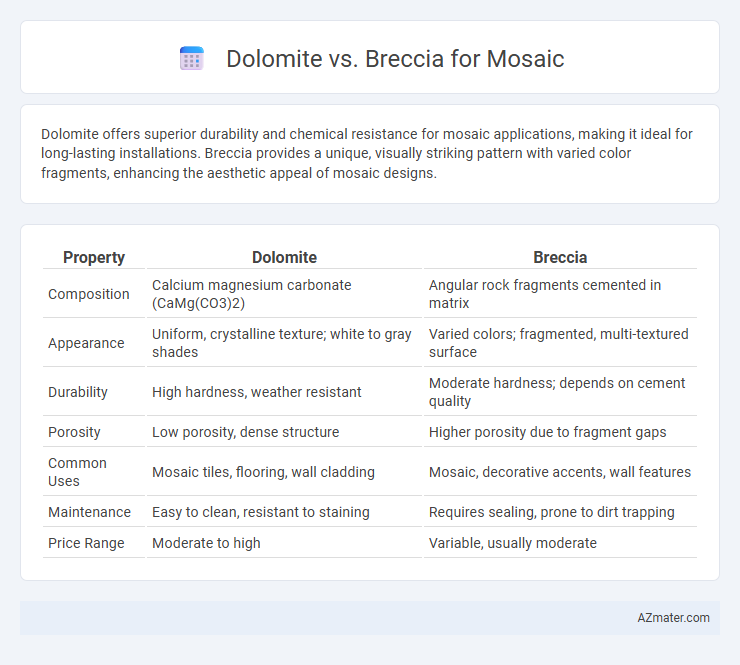Dolomite offers superior durability and chemical resistance for mosaic applications, making it ideal for long-lasting installations. Breccia provides a unique, visually striking pattern with varied color fragments, enhancing the aesthetic appeal of mosaic designs.
Table of Comparison
| Property | Dolomite | Breccia |
|---|---|---|
| Composition | Calcium magnesium carbonate (CaMg(CO3)2) | Angular rock fragments cemented in matrix |
| Appearance | Uniform, crystalline texture; white to gray shades | Varied colors; fragmented, multi-textured surface |
| Durability | High hardness, weather resistant | Moderate hardness; depends on cement quality |
| Porosity | Low porosity, dense structure | Higher porosity due to fragment gaps |
| Common Uses | Mosaic tiles, flooring, wall cladding | Mosaic, decorative accents, wall features |
| Maintenance | Easy to clean, resistant to staining | Requires sealing, prone to dirt trapping |
| Price Range | Moderate to high | Variable, usually moderate |
Introduction to Dolomite and Breccia
Dolomite is a sedimentary carbonate rock composed primarily of the mineral dolomite, characterized by its fine crystalline structure and resistance to weathering. Breccia consists of angular rock fragments cemented together by a finer matrix, often showcasing varied colors and textures ideal for mosaic design. Both materials offer unique aesthetics and durability, making them popular choices in architectural and decorative applications.
Geological Origins of Dolomite and Breccia
Dolomite, a sedimentary carbonate rock composed primarily of the mineral dolomite (CaMg(CO3)2), forms through the diagenetic alteration of limestone by magnesium-rich fluids, resulting in a crystalline structure favorable for mosaics. Breccia, characterized by angular fragments of various rocks cemented together, originates from mechanical weathering or tectonic activity that breaks and recombines rock masses, providing a unique, heterogeneous texture ideal for decorative mosaic applications. Understanding these distinct geological origins highlights dolomite's uniform mineral composition versus breccia's composite nature, influencing their aesthetic and structural properties in mosaic art.
Physical Properties Comparison
Dolomite exhibits higher hardness, typically around 3.5 to 4 on the Mohs scale, compared to breccia's variable hardness due to its composite nature. Dolomite's crystalline structure provides greater resistance to abrasion and chemical weathering, making it more durable for mosaic applications. Breccia, composed of angular fragments cemented together, offers unique aesthetic textures but may show inconsistent strength and porosity, affecting long-term performance in mosaics.
Color and Texture Variations
Dolomite offers subtle color variations ranging from white to light gray with occasional pink hues, characterized by a smooth, fine-grained texture ideal for sleek mosaic designs. Breccia presents a more dramatic palette with rich, earthy tones such as deep reds, browns, and greens, featuring angular, fragmented patterns that create striking textural contrast in mosaics. These distinct color and texture variations influence the aesthetic impact, with dolomite lending elegance and uniformity, while breccia provides boldness and dynamic visual interest.
Durability and Strength in Mosaics
Dolomite offers high durability and strength in mosaic applications due to its crystalline structure and resistance to abrasion, making it ideal for high-traffic areas. Breccia, characterized by its angular fragments cemented together, provides moderate strength but may be more prone to chipping under heavy impact. The dense composition of dolomite ensures longer-lasting mosaics with superior load-bearing capacity compared to the often less uniform breccia stone.
Workability and Cutting Ease
Dolomite offers superior workability and cutting ease compared to breccia, making it a preferred choice for mosaic artisans. Its fine-grained crystalline structure allows for precise cuts and smoother edges, enhancing intricate design possibilities. Breccia's heterogeneous composition and varied hardness result in uneven cutting resistance, requiring more effort and specialized tools to achieve similar precision.
Aesthetic Applications in Mosaic Art
Dolomite offers a smooth texture and subtle color variations, making it ideal for mosaic art that requires a refined, elegant appearance. Breccia features angular fragments and vibrant contrasts, providing dynamic patterns and bold visual interest in mosaics. Selecting between dolomite and breccia depends on the desired aesthetic impact, with dolomite enhancing uniformity and breccia delivering striking, textured designs.
Cost and Availability Factors
Dolomite is generally more cost-effective than breccia due to its widespread availability and easier extraction processes, making it a preferred choice for mosaics on a budget. Breccia, characterized by its unique angular fragments and varied coloration, tends to be more expensive and less readily available, impacting both cost and procurement time. Availability of local quarries significantly influences the final cost, with dolomite often sourced closer to urban centers, reducing transportation expenses compared to breccia's more limited and geographically specific deposits.
Maintenance and Longevity
Dolomite mosaics exhibit superior durability and require minimal maintenance due to their dense, non-porous structure that resists staining and weathering. Breccia mosaics, composed of angular fragments cemented together, may demand more frequent sealing and care to prevent water infiltration and surface degradation. Selecting dolomite enhances long-term aesthetics and reduces upkeep costs compared to breccia in high-traffic or exterior mosaic applications.
Choosing Between Dolomite and Breccia for Your Mosaic Project
Choosing between dolomite and breccia for your mosaic project depends on the desired aesthetic and durability. Dolomite offers a smooth texture and subtle, consistent coloration ideal for refined designs, while breccia provides a bold, fragmented appearance with varied colors and patterns, lending a dynamic, natural look. Consider environmental exposure and wear; dolomite is more resistant to weathering, making it suitable for outdoor mosaics, whereas breccia's unique veining adds artistic flair primarily suited for indoor settings.

Infographic: Dolomite vs Breccia for Mosaic
 azmater.com
azmater.com